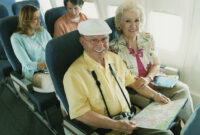Vacations for elderly individuals present unique opportunities for relaxation, rejuvenation, and creating lasting memories. Planning a trip that caters to the specific needs and preferences of older travelers requires careful consideration of various factors, from accessibility and health concerns to budgeting and companionship. This guide delves into the essential aspects of planning memorable and fulfilling vacations for seniors, ensuring a safe, enjoyable, and enriching experience.
We’ll explore diverse vacation types suitable for different activity levels and mobility needs, highlighting senior-friendly destinations and offering practical advice on health and safety, budgeting, transportation, and social aspects of travel. Through detailed examples and insightful tips, we aim to empower you to plan the perfect getaway for your loved ones or yourself.
Types of Vacations for Seniors
Planning a vacation for senior travelers requires careful consideration of their physical abilities and preferences. The ideal trip should be enjoyable, safe, and cater to individual needs, ensuring a memorable and rejuvenating experience. Choosing the right type of vacation is crucial for a successful and comfortable getaway.
Vacation Types Categorized by Activity Level
Selecting a vacation that matches the senior traveler’s activity level is paramount. This ensures the trip is both enjoyable and manageable, preventing undue stress or fatigue. Options range from relaxing retreats to more active adventures, each with its own set of advantages and disadvantages.
| Vacation Type | Activity Level | Pros | Cons |
|---|---|---|---|
| Relaxing Cruise | Relaxing | Minimal physical exertion, numerous amenities onboard, diverse dining options, pre-planned itineraries, opportunity for socialization. | Can be expensive, potential for seasickness, limited opportunities for independent exploration, may not suit those with mobility issues requiring frequent assistance. |
| All-Inclusive Resort Stay | Moderate | Convenient, pre-arranged activities available, various dining options, on-site amenities (pools, spas), less planning required. | Can feel isolated from local culture, potentially less stimulating for active seniors, may not offer diverse activities to cater to all interests. |
| Guided Walking Tour (in a city with accessible infrastructure) | Moderate | Engaging, opportunity to learn about local history and culture, moderate physical activity, social interaction with fellow travelers and guide. | Requires a reasonable level of mobility and stamina, weather dependent, pace may not be suitable for all fitness levels. |
| National Park Road Trip (with accessible viewpoints and facilities) | Moderate to Active (depending on chosen activities) | Stunning scenery, opportunities for photography and wildlife viewing, flexible itinerary, can be adapted to suit different mobility levels by selecting accessible trails and viewpoints. | Requires a vehicle and potentially long driving distances, weather dependent, may require assistance with mobility on some trails. |
| Spa Retreat | Relaxing | Focus on relaxation and rejuvenation, therapeutic treatments, peaceful environment, opportunities for quiet reflection and rest. | Can be expensive, may not suit seniors seeking more active vacations, limited opportunities for sightseeing or exploration. |
Accessibility and Senior-Friendly Destinations
Planning a vacation for a senior loved one requires careful consideration of accessibility to ensure a comfortable and enjoyable experience. Many factors contribute to a truly senior-friendly trip, extending beyond simply booking a hotel with an elevator. Careful planning minimizes potential difficulties and maximizes the opportunity for a memorable getaway.
Choosing a destination with excellent accessibility features is paramount. This involves looking beyond the typical tourist brochures and delving into the specifics of what makes a location truly senior-friendly. Overlooking accessibility can lead to frustrating and potentially dangerous situations, undermining the overall enjoyment of the vacation.
Accessible Transportation Options
Transportation plays a crucial role in a senior’s travel experience. Many destinations offer accessible transportation options, easing the burden of navigating unfamiliar areas. For example, cities like Amsterdam boast extensive tram and bus networks with low-floor vehicles and ramps, facilitating wheelchair access. Similarly, many major airports offer assistance programs for elderly passengers, including wheelchair assistance and priority boarding. Planning transportation in advance, confirming accessibility features, and booking assistance services where needed, is crucial for a smooth travel experience. Pre-booking accessible taxis or ride-sharing services can also alleviate potential transportation anxieties.
Accessible Lodging Accommodations
Finding lodging that caters to seniors’ needs is essential. Many hotels and resorts now offer accessible rooms featuring features such as roll-in showers, grab bars, wider doorways, and adjustable beds. When booking, it’s crucial to explicitly request an accessible room and verify the specific features available. Beyond the room itself, consider the hotel’s overall accessibility – ramps, elevators, and accessible common areas. Reviewing online reviews from other senior travelers can offer valuable insights into the practical accessibility of a hotel. Consider resorts that offer accessible bungalows or villas for more privacy and space.
Accessible Attractions and Activities
Many attractions are becoming increasingly accessible, but not all are created equal. Before booking tours or activities, confirm accessibility features such as ramps, elevators, and accessible restrooms. Consider the pacing of tours and activities; ensure they are not too strenuous or involve excessive walking. Many museums and historical sites offer wheelchair rentals and provide audio guides. Choosing activities that suit the senior’s physical capabilities is key; consider gentler options like boat tours or scenic drives as alternatives to strenuous hikes. Pre-booking tickets and arranging for assistance, where needed, can help manage time and reduce stress.
Accessibility Checklist for Vacation Destinations
Before finalizing a vacation plan, it is highly recommended to use a checklist to assess the accessibility of the chosen destination. This proactive approach can significantly contribute to a more enjoyable and stress-free experience for senior travelers.
| Category | Accessibility Features to Check | Example |
|---|---|---|
| Transportation | Airport accessibility, public transportation options (buses, trains, trams), accessible taxis or ride-sharing services, availability of wheelchair assistance. | Confirming the presence of ramps and elevators at the airport, checking the website of the public transport system for accessibility information, pre-booking accessible taxi services. |
| Lodging | Accessible rooms (roll-in showers, grab bars, wider doorways, adjustable beds), elevators, ramps, accessible common areas. | Contacting the hotel directly to inquire about the availability of accessible rooms and their specific features, checking online reviews for feedback on accessibility. |
| Attractions | Ramps, elevators, accessible restrooms, wheelchair rentals, audio guides, pacing of tours and activities. | Checking the website of the attraction for accessibility information, contacting the attraction directly to inquire about accessibility features and assistance services. |
Health and Safety Considerations
Planning a vacation is exciting, but for senior travelers, prioritizing health and safety is paramount. A well-prepared trip ensures peace of mind and allows for a more enjoyable experience. This section details essential precautions to take before, during, and after your journey.
Pre-Trip Preparations are Crucial for a Smooth Journey
Pre-Trip Medical Consultations
Before embarking on any trip, a consultation with your physician is highly recommended. This allows for a review of your current health status, medications, and any potential risks associated with travel. Your doctor can provide necessary vaccinations, discuss potential health concerns specific to your destination, and advise on managing pre-existing conditions during your travels. They can also provide you with a comprehensive medical summary including allergies and any relevant medical history to carry with you. This proactive approach minimizes potential health complications and ensures you receive appropriate care if needed.
Travel Insurance and Emergency Contact Information
Comprehensive travel insurance is a vital investment for senior travelers. It provides coverage for medical emergencies, trip cancellations, lost luggage, and other unforeseen circumstances. Ensure your policy adequately covers medical evacuation, which can be particularly expensive. Before you leave, make a list of emergency contacts including family, friends, your physician, and your insurance provider, and store it both digitally and physically in multiple locations. Consider sharing this information with a trusted individual who will not be traveling with you.
Managing Medications and Health Conditions While Traveling
Managing medications while traveling requires careful planning. Carry sufficient medication in its original packaging with clear labeling. Check the regulations of your destination regarding the transportation of medications. Pack medications in your carry-on luggage to avoid delays or loss. If you have a specific diet due to a health condition, research restaurants and grocery stores near your accommodation to ensure you can access appropriate food. It is also wise to bring a small first-aid kit containing essential supplies like bandages, antiseptic wipes, and any personal medications you may need for minor ailments. Consult your doctor about potential medication interactions or adjustments that may be necessary due to changes in your environment or activity level.
Resources and Organizations for Assistance
Several organizations offer support and resources to senior travelers. AARP (American Association of Retired Persons) provides travel advice and discounts. Many travel agencies specialize in senior travel and offer customized itineraries with accessibility considerations. Additionally, your physician or local health department can offer valuable advice and resources specific to your health needs and travel destination. The CDC (Centers for Disease Control and Prevention) website offers up-to-date information on health advisories and travel recommendations for various destinations worldwide.
Companionship and Social Aspects
For many seniors, travel is as much about the social connections as it is about the destination. The decision to travel alone or with companions significantly impacts the overall experience, offering unique benefits and challenges. Understanding these nuances is crucial for planning a fulfilling and enriching trip.
Traveling alone offers independence and the freedom to personalize the itinerary, catering to individual preferences and pacing. However, it can also lead to feelings of loneliness, especially in unfamiliar surroundings. Conversely, traveling with companions, whether family, friends, or a group, provides built-in social interaction and shared experiences, offering comfort and security. However, compromising on itinerary choices and travel styles is inevitable.
Solo Travel vs. Companion Travel for Seniors
Solo travel allows for complete autonomy in decision-making, allowing seniors to explore at their own pace and choose activities that truly interest them. They can linger longer at museums, take spontaneous detours, or simply relax without the need to compromise. However, this freedom comes with the responsibility of managing all aspects of the trip independently, which can be challenging for some seniors. Potential downsides include increased vulnerability to unforeseen circumstances and a higher risk of feeling isolated.
Traveling with companions offers a sense of security and shared responsibility. Friends or family can provide assistance with luggage, navigation, or any unexpected health issues. The shared experiences create lasting memories and foster deeper bonds. However, compromises on itineraries and activity choices are necessary, potentially leading to dissatisfaction if travel styles clash.
Examples of Senior-Specific Group Tours
Many tour operators cater specifically to the needs and interests of seniors, offering group tours with a strong emphasis on social interaction. These tours often feature a slower pace, accessible accommodations, and itineraries designed to minimize physical exertion while maximizing opportunities for socialization.
For example, a tour focusing on historical sites might include leisurely guided walks, ample time for exploration, and opportunities for informal discussions among participants. A cruise specifically for seniors might offer onboard activities like bridge tournaments, trivia nights, and themed parties, fostering a sense of community. Similarly, a tour focused on culinary experiences might incorporate cooking classes and opportunities to share meals with fellow travelers, encouraging interaction and camaraderie.
Creating a Balanced Travel Itinerary
A well-planned itinerary balances relaxation with social interaction. It’s crucial to incorporate downtime for rest and rejuvenation, interspersed with opportunities for engaging activities and socializing. This might involve a mix of structured group activities and independent exploration.
For example, a day might include a guided walking tour of a historical city in the morning, followed by an afternoon of relaxation at a spa or by the pool, and an evening enjoying a group dinner with fellow travelers. This balanced approach caters to both the need for rest and the desire for social engagement, ensuring a fulfilling and enjoyable travel experience for seniors.
Transportation Options for Seniors
Choosing the right transportation method is crucial for a stress-free and enjoyable senior vacation. Different modes of transport offer varying levels of comfort, accessibility, and convenience, and the best option will depend on individual needs and the destination. This section will explore several popular options, highlighting their advantages and disadvantages for elderly travelers.
Air Travel for Seniors
Air travel can be efficient for long distances, but it presents unique challenges for seniors. The process, from navigating airports to enduring long flights, can be physically demanding. However, airlines often offer assistance programs and amenities designed to ease the journey for older passengers. Consider factors like flight duration, potential layovers (which increase fatigue), and the accessibility of the aircraft and airport facilities. For example, a direct flight is preferable to one with multiple connections, reducing the strain of navigating multiple airports and security checkpoints.
Cruise Ship Travel for Seniors
Cruises offer an all-inclusive vacation experience, often including transportation, meals, and entertainment. This eliminates the need for frequent packing and unpacking, a significant advantage for seniors. The onboard amenities and accessible facilities cater specifically to the needs of older travelers, often providing assistance with mobility and other needs. However, the confined space of a ship might feel overwhelming for some, and seasickness is a potential concern. Larger cruise lines usually have better accessibility features than smaller ones.
Train Travel for Seniors
Train travel offers a more relaxed pace compared to air travel, with wider seats and more legroom than most airplanes. Scenic routes can be particularly appealing. Accessibility features vary widely depending on the train line and country. However, train travel can be slower than air travel, and longer journeys might be tiring for some seniors. For example, Amtrak in the United States offers accessible accommodations on many routes, including wheelchair-accessible cars and assistance with boarding.
Rental Car Travel for Seniors
Rental cars provide flexibility and independence, allowing seniors to explore at their own pace. However, driving long distances can be tiring, and navigating unfamiliar roads and parking can present challenges. Seniors should assess their driving abilities and consider the distances involved before opting for this option. Additionally, renting an accessible vehicle might be necessary depending on mobility needs. For instance, a vehicle with hand controls could be essential for someone with limited mobility in their legs or feet.
Tips for Easier Air Travel for Elderly Passengers
Planning ahead is key to a smoother air journey. Here are some helpful tips:
- Book flights with ample legroom and choose seats near the restroom for easy access.
- Request assistance from the airline for boarding and deplaning, especially if you have mobility issues.
- Pack medications and essential items in your carry-on luggage to avoid delays.
- Inform the airline about any specific medical needs or disabilities in advance.
- Allow extra time for security checks and navigating the airport.
- Bring comfortable clothing and shoes for the journey.
- Stay hydrated during the flight by drinking plenty of water.
- Consider bringing a neck pillow and eye mask for better sleep.
Conclusive Thoughts
Ultimately, planning a vacation for elderly individuals is about creating a tailored experience that prioritizes comfort, safety, and enjoyment. By carefully considering the factors outlined in this guide – from accessibility and health considerations to budgeting and companionship – you can ensure a memorable and fulfilling trip that celebrates the spirit of adventure and creates lasting positive memories. Remember that the key is to personalize the journey, focusing on the individual’s unique needs and desires to create a truly special experience.




